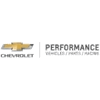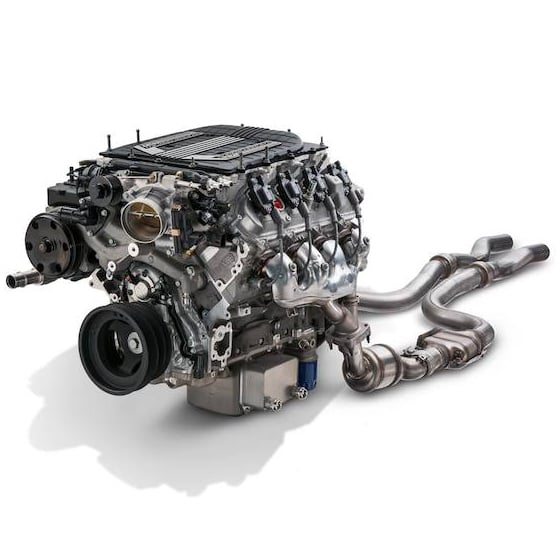Items You Need
Crate Engine
E-Rod engines include all the necessary emissions equipment and CARB EO number making the LT4 street legal when swapped into a 1995 and earlier vehicle. GM Gen V LT4 engines feature a compact 1.7L Eaton R1740 TVS supercharger that generates more than 9 pounds of boost to produce 650 horsepower and 650 lb.-ft. of torque. The cylinder heads are manufactured with Rotocast A356T6 aluminum casting which is tougher and handles heat better over conventional castings while the lightweight titanium intake valves help keep a stable valvetrain at higher RPM.
E-ROD LT4 Gen-V TECH SPECS
- Engine Type: LT-Series Gen V Small-Block V-8
- Displacement: 376 ci (6.2L)
- Bore x Stroke: 4.065 in. x 3.622 in. (103.25 x 92 mm)
- Block: Cast-aluminum with six-bolt, cross-bolted main caps
- Crankshaft: Forged steel. 8-bolt flange
- Connecting Rods: Forged powdered metal
- Pistons: Forged aluminum
- Camshaft Type: Hydraulic roller, billet steel
- Valve Lift: .492 in. intake / .551 in. exhaust
- Camshaft Duration (@.050 in.): 189-degree intake / 223-degree exhaust
- Cylinder Heads: Aluminum, Rectangular Port Direct Injection
- Combustion Chamber: 65.500 cc
- Valve Size: 2.130 in. intake / 1.590 in. exhaust
- Compression Ratio: 10.1:1
- Rocker Arms: Investment-cast, roller trunnion
- Rocker Arm Ratio: 1.81:1
- Recommended Fuel: Premium
- Maximum Recommended rpm: 6600
- Reluctor Wheel: 58X
- Balanced: Internal
Installation Notes:
- Engines shipped with high-pressure direct-injection fuel pump installed
- Intended for pre-1976 street vehicles or any off-road vehicle
- Not intended for marine applications
- Front-End Accessory Drive Kit p/n 809-can be ordered separately
- 8-bolt crankshaft flange
- Shipped with 14 in. flexplate
Required for Installation
- Fuel tank
- Fuel lines (recirculating or returnless)
- High-pressure fuel pump with 65 psi (450 kPa)
- Fuel tank vent line from the tank to the evaporative emissions canister
- Purge line from the canister to the engine purge solenoid
- Air induction system that incorporates the mass airflow sensor
- Exhaust system behind the catalytic converters
- A compatible front end accessory drive kit is required
Engine Break-In Procedure
Use only engine oil that meets dexos1 specifications. For track events or competitive driving, use Mobil 1 15W-50 engine oil. Fill the engine with oil and follow the proper engine priming procedure. Also check and fill as required any other necessary fluids such as coolant, power steering fluid, etc.
Start the engine and listen for any unusual noises. If no unusual noises are noted, run the engine at approximately 1000 RPM until normal operating temperature is reached. The engine should be driven at varying loads and conditions for the first 30 miles or one hour without wide open throttle (WOT) or sustained high RPM accelerations. Run five or six medium throttle (50%) accelerations to about 4000 RPM and back to idle (0% throttle) in gear. Run two or three hard throttle (WOT 100%) accelerations to about 4000 RPM and back to idle (0% throttle) in gear.
Change the engine oil and filter. Inspect the oil and the oil filter for any foreign particles to ensure that the engine is functioning properly. Drive the next 500 miles (12 to 15 engine hours) under normal conditions. Do not run the engine at its maximum rated engine speed. Also, do not expose the engine to extended periods of high load. Change the oil and filter again, inspect the oil and oil filter for any foreign particles to ensure that the engine is functioning properly.
Motor Vehicles
WARNING: Motor vehicles contain fuel, oils and fluids, battery posts, terminals and related accessories which contain lead and lead compounds and other chemicals known to the State of California to cause cancer, birth defects and other reproductive harm. These chemicals are found in vehicles, vehicle parts and accessories, both new and as replacements. When being serviced, these vehicles generate used oil, waste fluids, grease, fumes and particulates, all known to the State of California to cause cancer, birth defects, and reproductive harm.
Tools:
WARNING: Some dust created by power sanding, sawing, grinding, drilling, and other construction activities contains chemicals known to the State of California to cause cancer and birth defects or other reproductive harm. Some examples of these chemicals are: lead from lead-based paints, crystalline silica from bricks and cement and other masonry products, and arsenic and chromium from chemically treated lumber. Your risk from exposure to these chemicals varies, depending on how often you do this type of work. To reduce your exposure, work in a well-ventilated area and with approved safety equipment, such as dust masks that are specially designed to filter out microscopic particles.
Electrical Cords
WARNING: The wires of these products contain chemicals known to the State of California to cause cancer and birth defects or other reproductive harm. Wash hands after handling.



